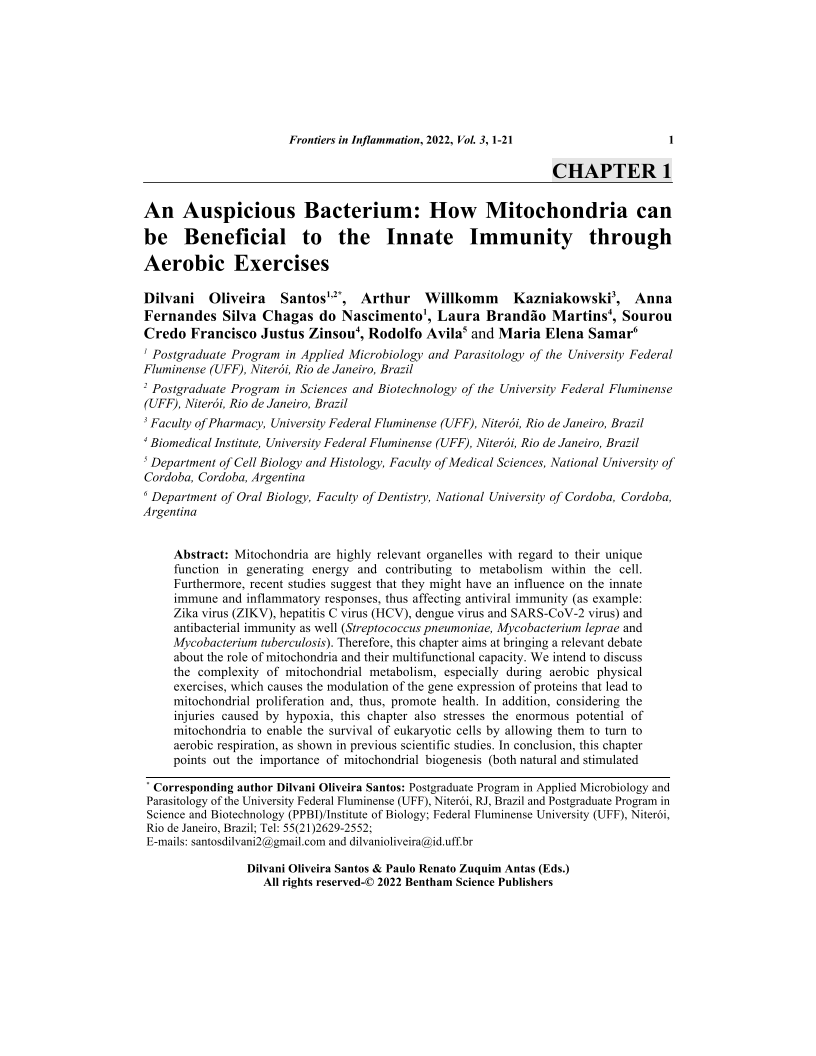An Auspicious Bacterium: How Mitochondria can be Beneficial to the Innate Immunity through Aerobic Exercises

- Authors: Dilvani Oliveira Santos1,2, Arthur Willkomm Kazniakowski3, Anna Fernandes Silva Chagas do Nascimento4, Laura Brandão Martins5, Sourou Credo Francisco Justus Zinsou6, Rodolfo Avila7, Maria Elena Samar8
-
View Affiliations Hide Affiliations1 Postgraduate Program in Applied Microbiology and Parasitology of the University FederalFluminense (UFF), Niterói, Rio de Janeiro, Brazil 2 Postgraduate Program in Sciences and Biotechnology of the University Federal Fluminense (UFF), Niterói, Rio de Janeiro, Brazil 3 Faculty of Pharmacy, University Federal Fluminense (UFF), Niterói, Rio de Janeiro, Brazil 4 Postgraduate Program in Applied Microbiology and Parasitology of the University Federal Fluminense (UFF), Niterói, Rio de Janeiro, Brazil 5 Biomedical Institute, University Federal Fluminense (UFF), Niterói, Rio de Janeiro, Brazil 6 Biomedical Institute, University Federal Fluminense (UFF), Niterói, Rio de Janeiro, Brazil 7 Department of Cell Biology and Histology, Faculty of Medical Sciences, National University ofCordoba, Cordoba, Argentina 8 Department of Oral Biology, Faculty of Dentistry, National University of Cordoba, Cordoba, Argentina
- Source: Mitochondrial DNA and the Immuno-inflammatory Response: New Frontiers to Control Specific Microbial Diseases , pp 1-21
- Publication Date: August 2022
- Language: English
An Auspicious Bacterium: How Mitochondria can be Beneficial to the Innate Immunity through Aerobic Exercises, Page 1 of 1
< Previous page | Next page > /docserver/preview/fulltext/9789815051698/chap1-1.gif
Mitochondria are highly relevant organelles with regard to their unique function in generating energy and contributing to metabolism within the cell. Furthermore, recent studies suggest that they might have an influence on the innate immune and inflammatory responses, thus affecting antiviral immunity (as example: Zika virus (ZIKV), hepatitis C virus (HCV), dengue virus and SARS-CoV-2 virus) and antibacterial immunity as well (Streptococcus pneumoniae, Mycobacterium leprae and Mycobacterium tuberculosis). Therefore, this chapter aims at bringing a relevant debate about the role of mitochondria and their multifunctional capacity. We intend to discuss the complexity of mitochondrial metabolism, especially during aerobic physical exercises, which causes the modulation of the gene expression of proteins that lead to mitochondrial proliferation and, thus, promote health. In addition, considering the injuries caused by hypoxia, this chapter also stresses the enormous potential of mitochondria to enable the survival of eukaryotic cells by allowing them to turn to aerobic respiration, as shown in previous scientific studies. In conclusion, this chapter points out the importance of mitochondrial biogenesis (both natural and stimulated biogenesis by aerobic exercise) and the benefits this organelle brings to the health, arguing that they go far beyond cellular respiration and oxidative phosphorylation.
-
From This Site
/content/books/9789815051698.chap1dcterms_subject,pub_keyword-contentType:Journal -contentType:Figure -contentType:Table -contentType:SupplementaryData105

